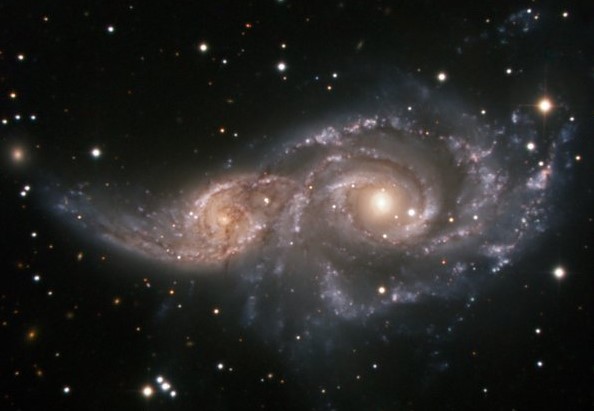New study from SAC: Oscillations from an old star reveal galactic collision
A new study of stellar oscillations from an old star reveals that the Milky Way collided with a dwarf galaxy about 11 billion years ago. Behind the study, which was recently published in the scientific journal Nature Astronomy, is a large international research team, including researchers from the DNRF Center of Excellence Stellar Astrophysics Centre (SAC) at Aarhus University.

In a newly published article in Nature Astronomy, a research team describes how a study of stellar oscillations from an old star called v Indi reveals a galactic collision between the Milky Way and a passing dwarf galaxy called Gaia-Enceladus, which took place during the life span of the old star. The research team behind the discovery includes several researchers from the DNRF center SAC at Aarhus University. The results are based on observations from NASA’s space telescope TESS and data caught by telescopes at the European Southern Observatory (ESO) in Chile.
“ν Indi is a lucky strike. It is close, and thus bright enough to enable us to study both the oscillations on its surface with the TESS satellite and also obtain fine spectrographic data from telescopes at the ESO La Silla Observatory in Chile. To supplement we have very precise determinations of the movements of the star from the ESA satellite Gaia. All in all, we can clearly see that ν Indi was formed in our own galaxy 11.0 billion years ago, but that the collision with the Gaia-Enceladus galaxy has moved our star away from its original orbit,” said Amalie Stokholm, a Ph.D. student at SAC and one of the authors behind the study.
Since its formation, the Milky Way has swallowed other smaller galaxies. When this happens, the stars from the swallowed galaxies move to orbits in the Milky Way different from those of the “native” stars and the new incoming stars usually also have a different composition of elements. Thus, v Indi was pushed out of its original position in the Milky Way, so to speak, and into another orbit where it differs from the other stars. It is this other orbit, together with the new calculations of the star’s age, that enables the researchers to determine that Gaia-Enceladus and the Milky Way must have collided no more than 11.5 billion years ago.
“We can see that the Milky Way consists of several elements having different ages and different stellar compositions. Like archeologists, we are now digging down into these layers to learn of the origin and development of our own galaxy. Impacts with smaller and larger galaxies in the early history of the Milky Way have been very important for the development, and we are trying to separate the different events in both time and space,” said Associate Professor Victor Silva Aguirre from the Stellar Astrophysics Centre and one of the authors behind the study.
Twice as old as the sun
V Indi was observed with NASA’s planet-hunter TESS, which is especially used for hunting exoplanets around the brightest stars of the universe. Based on the collected data, and through asteroseismology, the researchers studied oscillations from the light of the stars and determined several fundamental properties, including the star’s age, which in this case was 11 billion years. This is equivalent to twice the age of the sun. Besides v Indi’s old age, the researchers determined that the star is one of the less metallic ones in the Milky Way and that its composition of elements indicates that it was formed in the outer reaches of the Milky Way also known as the halo. All this, combined with the fact that the star is located in the “wrong” place in the Milky Way, led the researchers to conclude that something, at some point, must have disturbed v Indi and that this must have happened after the star was created.
“Even though we know the ages of part of the stars originally formed in the dwarf galaxy, this is no help in determining when the collision proper took place. This is where ν Indi comes in,” said Ph.D. student and co-writer Jakob Rørsted Mosumgaard of SAC. He added:
“Shortly after the galactic collision a lot of new stars were formed out of the colliding interstellar gas clouds from the two galaxies. These new stars have gathered over time in what we name the thin disc of the Milky Way, and by determining the ages of these stars we will also be able to put constraints on the latest possible time of the collision – we are working on it!”
Read the scientific article in Nature Astronomy here
You can read more about the study in a press release from SAC here
